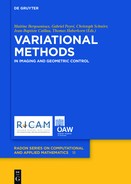Part II
The workshop Geometric control and related fields was held at RICAM from the 17th to 21st of November 2014. It gathered together 50 people (among them 15 invited speakers) from geometric control and related fields including Riemannian geometry and generalizations, Hamilton–Jacobi theory, celestial mechanics, quantum control, algebraic and numerical methods for ode’s and control. During the workshop, there were informal mini-courses given by J. Féjoz on KAM theory, D. Henrion on the control of polynomial systems, M. Mirrahimi on quantum control, and G. Stefani23on sufficient conditions in optimal control. F. Diacu also gave a public lecture on “Historical chronology: Truth or fable?” at Johannes Kepler University. We would like to acknowledge local help from D. Kalise, A. Kröner and Z. Rao, and to express our gratitude to RICAM for hosting the workshop and the semester.
This volume gathers nine contributions originating in the topics covered during the workshop. In their paper, P. Bettiol and N. Khalil give conditions to ensure normality (and more generally non-degeneracy) of the necessary conditions for optimal control problems with state constraints; the dynamics is described by a differential inclusion of weak regularity (only measurable w.r.t. time). B. Bonnard et al. investigate the optimal control of micro-swimmers using the Purcell three-link model; their analysis is based on an appropriate integrable nilpotent model, and they also emphasize the numerical computation of conjugate points for the resulting periodic trajectories. Z. Chen and Y. Chitour provide an analysis of practical controllability issues for the two-body problem; they study in detail orbital insertion and the deorbit problem. The theory of Morales–Ramis–Simó provides obstructions to the integrability of Hamiltonian systems, and T. Combot reviews in his paper the use of the variational equations of higher order in this respect; he studies in particular the case of homogeneous potentials that are defined on appropriate Riemann surfaces. In his contribution, J. Féjoz gives a detailed presentation of KAM theory in the analytic case using the normal form point of view of Herman; this normal form, obtained thanks to a procedure of Nash–Moser type, gives rise to a true dynamic conjugacy under additional non-degeneracy conditions. M.Grochowski andW. Kryński study a natural generalization of (sub-)Riemannian structures, namely the sub-pseudo-Riemannian ones; they compute the basic invariants of such structures. A second paper on swimming microorganisms is authored by J. Lohéac and J.-F. Scheid; they study a perturbation of the Brockett integrator, and propose a tailored numerical method. J.-P. Marco investigates in his paper an Arnold diffusion question in the group of symplectic diffeomorphisms on the annulus; the associated geometric analysis can be interpreted as a controllability result on this group. In a paper which is the first part of a review of the rich theory of sufficient conditions in optimal control, G. Stefani and P. Zezza give an account of the so-called Hamiltonian approach; they notably extend the analysis to the case of non C2 Hamiltonians.
Jean-Baptiste Caillau and Thomas Haberkorn
